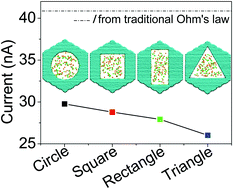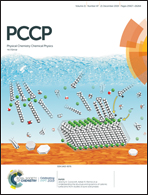Computational modeling of ionic currents through difform graphene nanopores with consistent cross-sectional areas†
Abstract
Understanding the mechanism of ion transport and the related ionic current through a nanopore is significant for improving the sensing accuracy of biophysical and diagnostic applications using the nanopore technology. Here, systematic theoretical studies of ionic current dependence on the geometry of a nanopore were performed. Surprisingly, it was found that the ionic current through a nanopore with a smaller perimeter was obviously larger than that through a nanopore with a larger perimeter although all the nanopores had consistent cross-sectional areas; this was also found for nanopores with different hydrophobicities. This interesting result originates from the decrease in ion concentration, mobility and conductivity in proximity to the nanopore surface. Besides, an obvious ionic current enhancement was observed for hydrophobic nanopores compared to that for the hydrophilic nanopores, which was caused by the increased ion mobility through the hydrophobic nanopores. A simple model that combined the distribution of ion conductivity as well as the traditional Ohm's law was successfully applied to predict the ionic current through difform nanopores with different hydrophobicities. This work will aid the development of high-resolution nanopore sensors in the near future.



 Please wait while we load your content...
Please wait while we load your content...